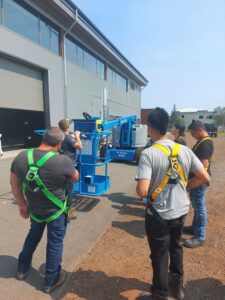Anishinabek Employment and Training Services helping First Nation students further their education

By Rick Garrick
THUNDER BAY — Anishinabek Employment and Training Services (AETS) is currently offering Continuing Education, Construction Craft Worker, and Cement Finishing programs for people affiliated with a First Nation. Information about the programs is posted online.
“We are here to help students who want to further their education, whether that be going on and getting an actual Grade 12 or getting those prerequisites they need for employment, apprenticeship or post-secondary education,” says Leslie MacGregor, program administrator for Continuing Education at AETS. “We’re open and flexible and we’ll work to make that best student success plan for each individual, so it’s an individualized plan, continuous intake and we’re open to help the students achieve their personal academic and employment goals.”
MacGregor says there is some priority for citizens of the nine AETS communities, which include Biinjitiwaabik Zaaging Anishinaabek, Red Rock Indian Band, Pays Plat, Netmizaaggamig Nishnaabeg, Biigtigong Nishnaabeg and Michipicoten, to apply for the Continuing Education Program, but because the program is virtual and online, it is open to on or off-reserve citizens from all First Nations.
“It’s an ongoing enrolment so you can enrol at any time that you want to,” says Adrienne Vandahl, teacher at Biigtigong Nishnaabeg Endzhi-gkinoohmaading Private High School. “And it’s flexible so students can work around their schedules and responsibilities. It can be full-time or part-time, it’s up to really the student what their plan is.”
MacGregor says they can do a Prior Learning Assessment and Recognition (PLAR) for the students, which can give them up to 16 high school credits through recognition of their experience and prior credits.
“We can look at your past work experiences and we can give you up to 10 credits for that,” Vandahl says. “And then there’s another PLAR for Grade 9 and 10 and that would offer you up to the 16 credits.”
Vandahl adds that students with an Ontario Secondary School Diploma can also take high school courses to gain the credits they need.
“We have students now who already have their diploma that are maybe taking the Grade 12 English or taking a Math course that helps them get into a certain trade,” Vandahl says.
AETS plans to launch the Construction Craft Worker Program on Jan. 10 and the Cement Finishing Program on Feb. 14 through a partnership with LiUNA (Labourers’ International Union of North America) and Origin, owned by Red Rock Indian Band’s Melissa Hardy-Giles.
“We actually just wrapped up our General Carpentry and our Drywall programs — we had about 26 graduates at our graduation event we had on Oct. 28,” says Trevor Meawasige, Pre-Apprenticeship Training coordinator at AETS. “We’ve worked with LiUNA in the past on the Cement Finisher and the Construction Craft Worker programs … from 2015-2018.”
Meawasige says the Construction Craft Worker program students can earn up to 30 tickets, such as rough terrain forklift, skid-steer, blueprint reading and health and safety components as well, and the Cement Finishing program students can earn up to 24 tickets.
“For some people, it would be a good way to update some of their tickets that are expiring,” Meawasige says. “For some people, it would be a good way also to explore new opportunities and be introduced to the industry. Because we are partnering with a union, they generally get registered with the union and get work and time that can be used towards getting an apprenticeship.”
Meawasige says the Construction Craft Worker and Cement Finisher programs have fully qualified instructors provided through LiUNA.
“There are Red Seal individuals that have a lot of experience in the industry and they are sharing that knowledge with the students in a safe environment,” Meawasige says.
Meawasige says they use Origin’s Immersive Link equipment to provide students with a virtual reality view of the work environment.
“It’s also a screening tool and an aptitude tool,” Meawasige says. “It’s a good way to screen individuals to get them to see if they might be a good fit for the program.”
Meawasige says AETS tries to remove as many barriers for students as possible, such as providing transportation to and from LiUNA, accommodations for people from out of town and childcare support.
“Generally, our goal is to serve our nine-member communities from the North Superior Region] but anyone can apply,” Meawasige says.

